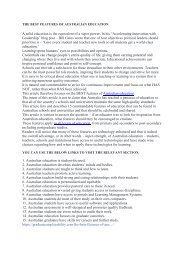THE BEST FEATURES OF AUSTRALIAN EDUCATION
There are several countries worldwide wherever students are able to study abroad for gratis or for a really cheap quantity. You simply have to be compelled to understand wherever to seem. Below you will find a range of nations that provide inexpensive or free tuition, with details on eligibility and what current university fees you’ll expect.
There are several countries worldwide wherever students are able to study abroad for gratis or for a really cheap quantity. You simply have to be compelled to understand wherever to seem. Below you will find a range of nations that provide inexpensive or free tuition, with details on eligibility and what current university fees you’ll expect.
Create successful ePaper yourself
Turn your PDF publications into a flip-book with our unique Google optimized e-Paper software.
STUDENT-FOCUSED<br />
Teaching does not matter if students do not learn. Metaphorically, imagine if a star-teacher<br />
from another planet came to teach in his alien language. It does not matter how accomplished<br />
that teacher is, if the students that are being taught cannot understand. Learning will not<br />
happen.<br />
Conversely, Australian teachers seek to understand whether their students are learning and if<br />
they are not, these teachers change their methods. In Australia, teaching is defined as all of<br />
the actions that the teacher undertakes that help students learn.<br />
Therefore teaching means lecturing and presenting content to the students. Teaching also<br />
means giving feedback on assessment, tutoring students who need extra help and meeting<br />
with families to understand the students’ context and what might be inhibiting learning.<br />
Being student-focused also means that Australian teachers focus on the whole student<br />
experience. They are interested, not only in interactions with students inside the classroom,<br />
but also students’ friendships and peer-support. Australian educators seek to help students to<br />
become well-rounded, balancing study, sport, music, leadership pursuit and other extracurricular<br />
activities.<br />
MINDS & BODIES<br />
Australia’s climate is conducive to spending time outdoors. Many parts of Australia have<br />
little variation between seasons with lots of days of sunshine throughout the year. Teachers<br />
are known to take their students outside, which increases opportunities for incidental<br />
learning. In addition, the Australian culture embraces competition, rivalry and<br />
adventuresome, outdoor pursuits.<br />
As a result, schools and universities tend to have a strong emphasis on sport, supporting all<br />
levels of participation from club-level to elite. There is also a reasonably high tolerance for<br />
physical risk and a less litigious environment compared to some other countries. Because<br />
schools have less worry about being sued, they are able to offer more rugged physical activity<br />
including adventure camps and more challenging playground equipment.<br />
Research has shown that physical activity and overall fitness stimulates mental performance.<br />
Australian students thrive in an environment where they are encouraged to develop both their<br />
minds and bodies. Fitness breaks rest their minds and can boost their academic performance.<br />
HOW TO THINK & LEARN<br />
In 1910, John Dewey, an educational theorist and thought-leader, wrote a paraphrased<br />
version of the proposition that – ‘it is not the purpose of education to teach every piece of<br />
information, but to train habits of mind and teach students how to differentiate between tested<br />
and untested beliefs.’<br />
This is even more relevant in the modern age where we have the internet. Students can now<br />
Google anything and receive countless Wikipedia and Youtube facts, descriptions,<br />
demonstrations and explanations. The teacher does not need to be the keeper (or conveyor) of<br />
information or the sage-on-the-stage. The teacher’s role is the guide-on-the-side.<br />
Australian teachers tend not to dole-out long lists of facts and figures, asking students to<br />
memorise and repeat. Instead, Australian teachers use approaches such as case studies and<br />
problem-based learning to teach students how to apply and assimilate knowledge. Learning<br />
how to think and how to learn, through their teachers’ guidance, allows students to achieve<br />
increasing independence for higher-level studies and how to think-on-their-feet in their<br />
eventual careers.




